Sistine Chapel Work of Art Its True Love Is Everywhere
Dear Refraction readers:
As the Cardinals gathered in the Sistine Chapel to (select who will be Pope Francis) consider a momentous decision for the future of the church, I pulled out an essay that I began to write two summers ago, after visiting the famed Michelangelo's Sistine Chapel. Until at present, I held back from publishing it, thinking that my observations might exist also radical. But a recent conversation with an artist I respect, Joel Sheesley, encouraged me to end this essay. Nosotros were at the library in Wheaton College, where Joel teaches, looking together at an etching copy of Raphael's masterpiece Transfiguration*, a painting that hangs in the Vatican merely a few yards from the Sistine Chapel.*
Michelangelo's Sistine Chapel, Raphael and a Yellowish Polar Carry
When my son Ty was iii years one-time, we took a trip to the Ueno Zoo in Tokyo. I explained to him that polar bears live in the Arctic Circle, and they are white to be camouflaged in the ice and the snow. (Call this early-childhood education in ecology and zoology.) Ty took ane look at the allegedly white behave walking about, and gave me a quizzical look: "Daddy that polar bear is yellow, non white!"
Ah, the importance of actually looking at the object in question; the importance of checking in with reality. Sure plenty, the Ueno Zoo polar bears are not really white; they are xanthous grey. Ty was right. I had assumed that polar bears are white, and taught my kid the false assumption I held, without actually looking at the polar bears walking around in front of me. Children often will await and report what they actually see, maybe for the first time. Adults have learned not to see.
As I've written in the past, the number one rule for date with culture is to look, see and heed. This statement by C. S. Lewis is worth quoting over again, reminding united states of this critical posture:
The first demand whatsoever work of fine art makes upon united states is surrender. Expect. Listen. Receive. Get yourself out of the way.
-C. South. Lewis, An Experiment in Criticism, pp. 18, 19 (Cambridge University Press)
How often we speak of the arts - whether paintings, sculptures or movies - based on hearsay, rather than actual personal experience. In the ideological age we live in, we often project what we think we are seeing (the polar behave is white), rather than the reality of experiencing. We do not take seriously Lewis' citation to "Look, Listen, Receive." We are non, as a civilization, ready to step outside of our "comfort zones" to experience what others are sensing-to "step into someone else'southward shoes." So our cultural foundation is congenital more on projected ideological assumptions than on bodily experiences. As my friend Bruce Herman tells me, using these principles of Lewis', "if you want to understand something, you demand to exist willing to 'stand nether' it."
I had a "polar bear" experience 2 summers ago in Rome. We were "standing under" the famed Sistine Chapel in the Vatican, a masterpiece of man expression by Michelangelo.
What nosotros know of the Sistine Chapel has been reduced in our minds; we automatically picture God the Male parent reaching out toward Adam with his finger, or the central figure of Christ in "The Final Judgment" wall, a magnificently contorted effigy of triumph. Here's how William E. Wallace, in his comprehensive and definitive book on Michelangelo, describes the Sistine Chapel:
In many ways the ceiling is a compendium, of Michelangelo's fine art, of the Renaissance, of Christian theology. Similar Beethoven's Ninth Symphony or Shakespeare's Hamlet, the ceiling is a transcendent work of genius that can never be exhausted through looking or describing. In the words of Goethe: "Until you take seen the Sistine Chapel, you lot can have no adequate conception of what man is capable of accomplishing.
-William East. Wallace, Michelangelo: The Consummate Sculpture, Painting, Architecture, p. 185 (Universe)
If any hype, whatsoever united adoration for an artwork, is appropriate, it is for this masterpiece. What I would tell my children if I were to take them to the Sistine Chapel is that this masterpiece of Renaissance expression is likewise a masterpiece of Christian patronage. It is a visual work of Christian theology; as Wallace notes, earlier the Enlightenment, the church was the greatest patron of fine art. The ceiling of the Sistine Chapel is, after all, the centerpiece of the Vatican. Information technology is a work of Michelangelo's genius and of his piety, a six-yr delivery to serve the crusade of the church. It is where the Cardinals are gathering to pray and take votes to select the next leader of the largest church in the world. Any writings about the fresco would echo Wallace's sentiment about how we see Genesis accounts now, after the Sistine Chapel:
In the total of ix scenes-four large and 5 smaller rectangular fields-Michelangelo related the book of Genesis. This was certainly not the first time the subject had been depicted, yet, like Leonardo's Final Supper it has get well-nigh the canonical representation; we visualize the first book of the Bible co-ordinate to Michelangelo. (140)
The assumption I had going into the Vatican was that encountering this work would be a transcendent, spiritual experience. Wallace states further:
…the ceiling causes us to pause awestruck at the artistic imagination and accomplishment of one human being. No one quite forgets the experience of stepping through the small doorway into the vast expanse of the Sistine Chapel and having one's eyes drawn inexorably to the heavens. (140)
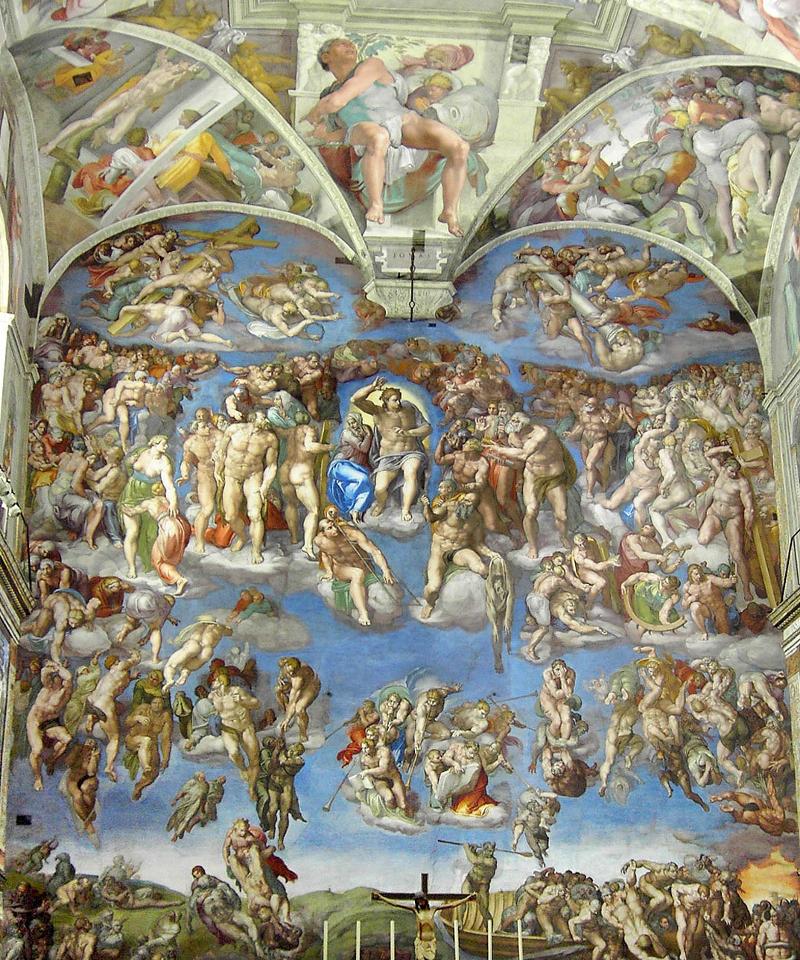
Subsequently about an 60 minutes of standing under Michelangelo's masterpiece, the assumptions began to disappear, and the real Sistine Chapel appeared. When I began to ponder was what I was surprised to observe, and reminded me of what Ty had said to me.
"Daddy, that polar conduct is not white, information technology's xanthous!"
As I observed, and took note of what I was seeing equally an creative person, I came to the conclusion that I needed to right my prior assumptions quite a scrap. Here'southward a quick summary of what I noted:
The Sistine Chapel is 1 of the nigh awkward worship spaces one will ever enter. While I have no problems calling the fresco a grand masterpiece of humanity, it is not the most transcendental worship space. The Sistine Chapel overwhelms, only non every bit a mysterious gaze into the heart of God. Past all accounts, Michelangelo was a devout man, but the space does the reverse of what Wallace claims; it does not bring one to a transcendent experience of "i's eyes drawn inexorably to the heavens." On the other hand, the work is a masterwork of confession. Though our eyes lift up to the ceiling at get-go, they volition eventually focus on the grand Last Judgment wall. But our gaze does not end upward on the figure of Christ at the center-our eyes are fatigued to a homo crouched in terror at the bottom of that wall. This effigy is caught between sky and hell, and it is key to understanding the Sistine Chapel.
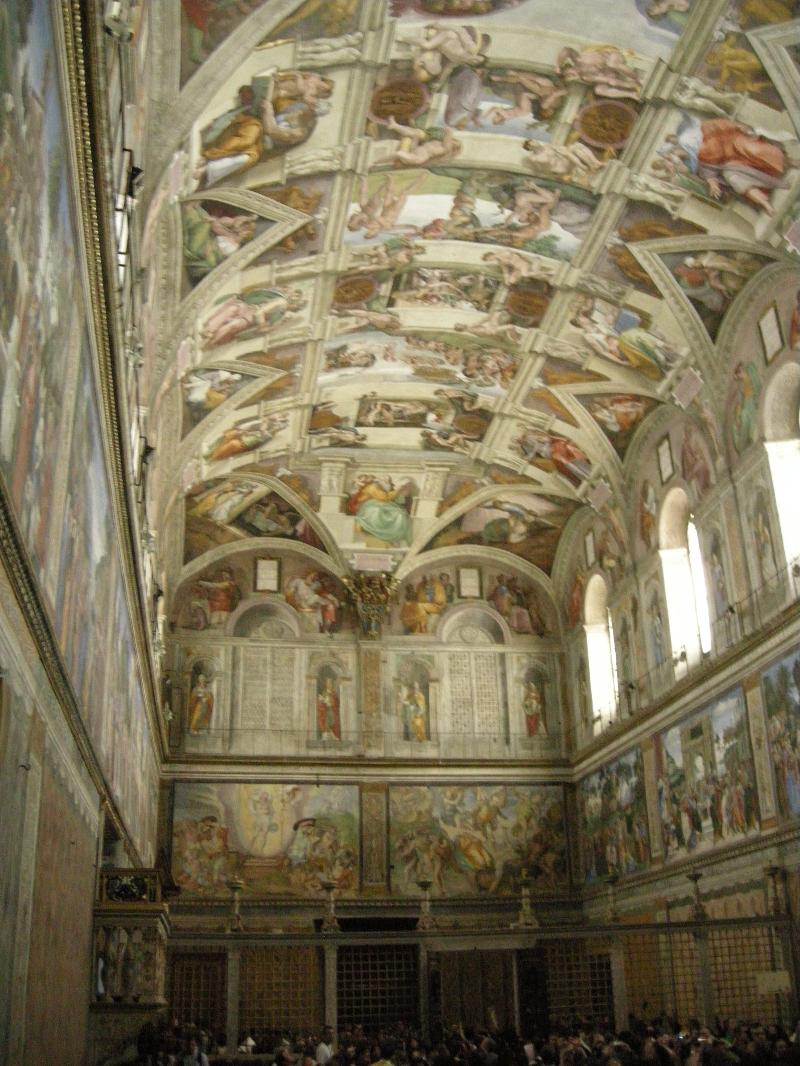
Rather beingness the epitome of transcendental worship before the Enlightenment fragmentation, Michelangelo'southward chapel ceiling is the first salvo of self-expression born of the schism that nosotros telephone call the Enlightenment, a logical path taken during and subsequently the Renaissance, a homo-centered world in which the heavens collapse into the anguished confront of a human being. The images of the Sistine Chapel reveal the centre of a man of enormous genius struggling to find his style in the world, struggling to "own" his committee, struggling to paint (he was primarily a sculptor upwards to this indicate), and struggling to know his God.
If I were a priest or a pastor invited to cull a special place to celebrate worship or to pray, I would non chose the Sistine Chapel. St Francis' Basilica in Assisi with Giotto'due south and Cimabue: Yes. St. Maria delle Grazie with da Vinci's The Terminal Supper: Yes. Even the Rothko Chapel would be a better choice. Michelangelo'south Sistine Chapel actually fights confronting worship. The images he spread across the ceiling visually compete with the crucifix on the altarpiece below; they, non the altarpiece, are the center.
Martin Luther visited Rome effectually the fourth dimension that Michelangelo was at work in the Sistine Chapel. There is no indication that Luther got a sneak meridian. Simply we practice know that he recoiled at what he saw in Rome during that visit. When he arrived, he idolized Rome, kissing the steps of Pilate's stairs in admiration, only he left with many questions on his heed. In many respects, the Sistine Chapel represents the earth Luther questioned. But in other ways, Michelangelo'south genius transcends the politics of the church, and that is the Sistine Chapel's greatest triumph.
Michelangelo was most capable of turning his devout soul into art non in fresco course, simply with a chisel. His lyrical, worshipful marble sculptures attest to this. He was far more suited to cleave marble, and that was his first language of worship. Nevertheless Michelangelo truly desired to glorify God, so he dutifully, though reluctantly, fulfilled Pope Julian 2's expectations and patronage.
What I observed every bit the starting time clue of a disconnect with the human action of painting is what is at the heart of the Last Judgment wall; it is a fundamental piece, and all the same, as my optics examined this central slice, I realized it was not central at all.
The figure of Christ is visually at the center, but information technology is not visually designed to do what it seems.
"Daddy, that polar bear is yellow!"
Before I go into my particular observations and "reading" of the paintings, permit me quote Wallace over again speaking of this figure of Christ:
The Lord looks with gentle eyebrow, equally if hoping to save one more soul before the damned disappear into hell'south maw…The subtle gesture of Christ'south left hand first calls attention to the wound in his side and and then, framed past the flesh of his trunk, initiates the resurrection of the dead. (185)
The supposition hither is that Christ is triumphant over the grave (visually, he is to a higher place hell, ascension), powerfully about to execute his judgment.
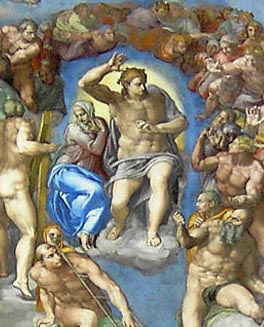
I tried to wait at this paradigm as though I did not know the Bible at all. I imagined looking at the figure of Christ not knowing anything virtually Christ. What would I see?
I would meet a Greco-Roman figure, the ideal of a human being form, an Apollonian god-but under oppression. The halo behind him, like a dying ember, is diminishing, sucked out by the enormous force per unit area coming from the powers of the compressed figures that environment the halo. The pillars above stand visually in the fashion of the effigy rising; there is an end coming, and the effigy is in anguish, having lost management. This Christ does not seem triumphant.
The path that the Sistine Chapel depicts may non be the path to heaven at all. Instead, one tin can run across in this paradigm a repression of humanity, repression of the sort that haunts modernity. David P. Goldman writes of another genius arising from the legacy of the Renaissance. In "Wagner's Incestuous Narcissism," he writes:
Narcissistic dearest knows neither the trials of courtship nor the fruitfulness of family life only just the climactic moment. In keeping with this thought of love, Wagner's music stakes everything on the musical climax. In contrast to classical composition, whose teleology and formal coherence conveys a sense of the journey toward redemption, Wagner's music offers united states the overpowering moment of ecstasy.
-First Things, August/September 2001, p. 26
Judging from Michelangelo's letters, it seems highly unlikely that he intended this type of narcissism in his art or in his life. But the trajectory of art often reveals what 1 intuits, more than what is on the surface of one's mind.
What Michelangelo's paintings reveal, about unintentionally, is the birth of an ideological, narcissistic age.
The word ideology, sociologist Tony Carnes has noted, has its root in the word idol. Any ideology, whether it be religious, sexual or political, can quickly get the sole means by which individuals approximate others, and in those people'southward minds the ideology replaces God every bit the ultimate judge of all things. Ane might argue that Michelangelo lived in a pre-ideological age, before the fragmentation of Enlightenment began to create distinct categories. Even Christian denominations did not be then-simply every bit Luther left Rome to head n, that schism was already present in Luther's heed. No one dorsum then would take been categorized equally a Protestant, and atheism or faithlessness did not exist as distinct categories. At that place was no demand to brand a defensive stance against the question "what denomination practise you vest to?" In other words, the category of atheism may not exist, every bit a public reality, apart from denominationalism.
Thus, Michelangelo had niggling involvement in creating a category of mail-Enlightenment art, "homo-erotic art" or ideation of any kind. Did he intentionally put into his work hints of a personal calendar toward the Pope, or any other power structures? Aye, near definitely. Was this an endeavour to create an ideological "code" of some kind? No.
***
The chapel is packed at present, with other tourists. Commanding voices of guards tell them to be hushful: "Silenzio!" The clamor dies down but for a moment, and then rises. If the figures surrounding the Christ/Apollo figure could speak, and we could hear them, they would be loud, anxious and incapable of silence, besides, every bit they twisted awkwardly into the frescoed walls. I and then look up to see the fingers of Adam.
In the famed "reach" of God to Adam, the conventional understanding is that it is God the Father reaching Adam. Simply visually, in actual reading, information technology does not read as such: it is depicting Adam as having an contained, democratic condition with God. They are two figures equal in visual significance. God is unable, in the equal weight, in the "yin and yang" of 2 forces, to reach Adam. Adam pulls his finger back; the selection is Adam'south, and not God's.
Theologically, one may besides probe deeper. Would non representation of God diminish God's invisible omnipotence? Michelangelo'due south efforts to describe God in itself is not a violation of the Second Commandment; the Second Commandment forbids creating and worshiping idols in the shape of what is visible, and therefore we are gratis, especially later on Christ'south appearance every bit a man, to create symbols or fifty-fifty a portrait of God. But the problem of depicting God the Male parent as a "effigy in the heaven" does present a theological puzzler. How do yous communicate an invisible Reality in a Person of the Creator while fixed entirely in the means of the visible reality? And if nosotros are to create a "portrait" of God, does that raise or inhibit true worship?
The post-Reformation answers to these questions have led some to create a minimalist, ascetic box, with restrictions against having whatever images inside church walls. The iconoclastic motility of banishing and destroying images could exist, in part, a reaction confronting the Sistine Chapel'due south grandeur, and confronting Michelangelo'southward audacity in depicting God as aristocratic and Christ as an Apollonian figure.
My optics so gazed at the Eden scene. The prelapsarian Adam and Eve are at center stage, and an image tells of the power of Satan; of form, that is how, Biblically, we should read the scene. Just in the unabridged chapel, there is no vision for the City of God, no vision for how the Tree of Life is to exist sought through Christ'south sacrifice. So the depiction of expulsion, in dissimilarity to the Eden temptation, is awkwardly stiff and visually static. The dualism is what misses the bespeak; evil is literally at the centre of this painting. The "expulsion" is not about the Autumn; rather it is depicted as a development of a post-Edenic identity. There's no up or down, heaven or earth; all figures are characters on the aforementioned stage. Thus our gaze does not transcend the painting, but ends up admiring Michelangelo'southward powers and genius. We end up request questions about the technique-"How did he manage to do this!" We exercise not bend our knees.
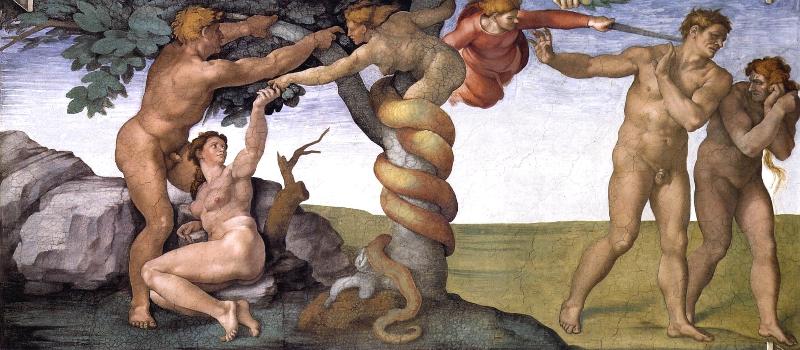
I used to assume that the Sistine Chapel represented the height of the Renaissance in worship of God. Now I consider it to take paved the style to Oscar Wilde and Friedrich Nietzsche. This should not cause any of us, including Christians, to avert these artworks and books. Instead, we should exist driven to them as they limited the angst, and the reality, of our times. Truth-seekers should assume that the faith reality is generative and tin can help us digest even atheistic art with great precision. If we once causeless the comport is white, merely and then observe information technology is non, we need to beginning to run into the comport in its true status, and consider why the bear is yellowish.
***
I walked downwardly, looking up and back occasionally to take a last glimpse of the magnificent dome of the Sistine Chapel; having exhausted the concluding hr staring, I entered into the last room of the Vatican intending to take just a quick look. What I saw there exhilarated me, filled me with joy and worship.
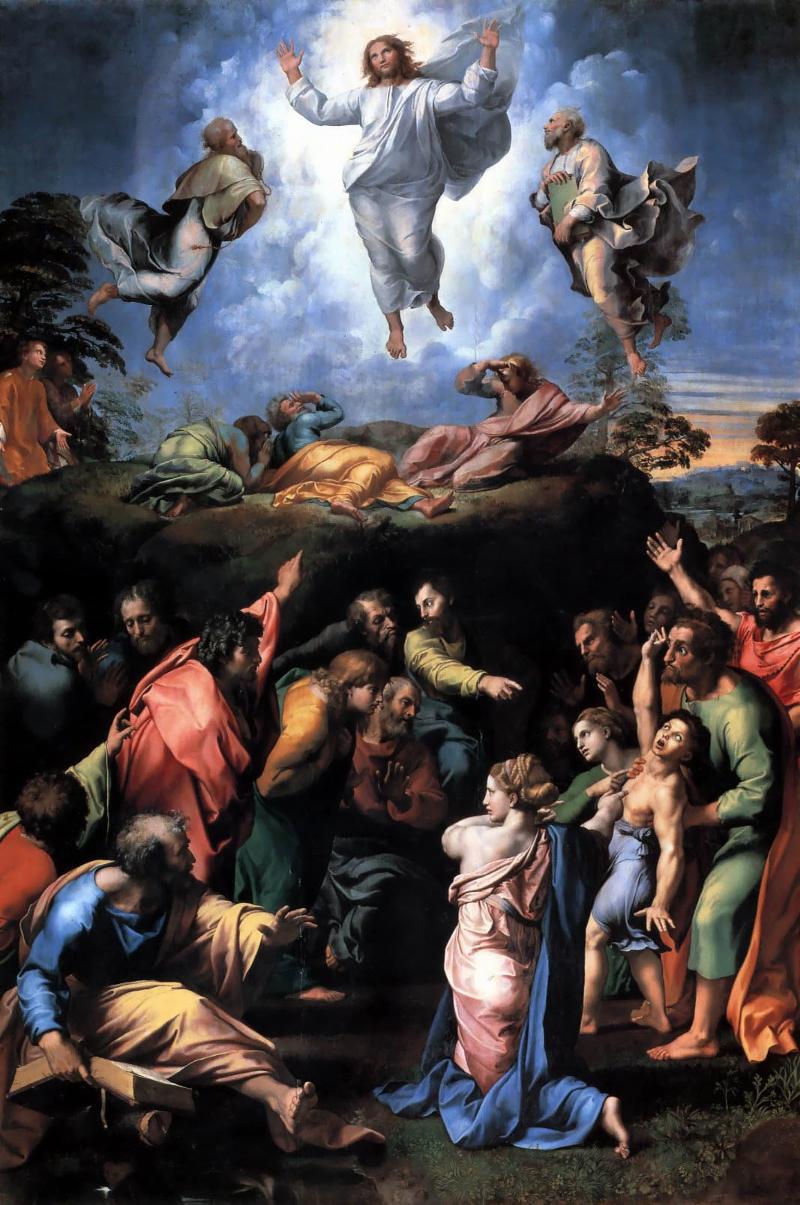
In the dimly lit hall is a painting past Raphael, the rival of Michelangelo, of the Transfiguration. At present, this is ALL nearly worship. The triumphant effigy of Christ is surrounded by Moses and Elijah. The disciples and others are stumbling about below, trying to do the work of Christ in the dark world beneath the transcendent figures. The contorted figures underneath of the battles upon the country draw, actually, the spiritual boxing backside liberating a demon-possessed boy who the disciples are trying to help. The boy seems to be having an epileptic fit; he is unable to focus, blind to himself and the globe. Just then I noticed something peculiar. In the entire painting, in that location are only a few figures whose gazes seem to truly exist upon Christ. The figure of one of the saints (most likely, St. Justus and Pastor, to whom the Feast Day of Transfiguration is dedicated), Moses and Elijah…and the boy. Of all the figures in the night underworld of spiritual battles, the demon-possessed male child is the merely one who is looking direct at Christ; he is the just ane who sees Christ.
The male child who cannot see, bounded past physical and spiritual bondage, still past organized religion sees the triumphant Christ. Raphael depicted the moment of liberation, and identified the peculiarity of worship that Luther would have appreciated: doxology begins with liberation from our possessions to see Christ.
Raphael lay ill during the completion of the painting (he was 37); co-ordinate to one account, he lay downwards beside it and continued to work. He died only a few hours later. It is probable, and then, that for Raphael, his own painting of the Transfiguration literally became his dying hours of worship.
If you travel to Rome and want to spend hours in the Vatican reflecting on the time to come of worship and the church, don't stand up beneath the chapel dome. Stand under Raphael's Transfiguration. There, in Raphael'southward masterpiece, the blinded, the helpless, refracting in the darkness of the terminal hours, can truly see. This painting is the true white polar bear I presumed I would see in the Sistine Chapel.
Source: https://makotofujimura.com/writings/refractions-38-michelangelos-sistine-chapel-raphael-and-a-yellow-polar-bear